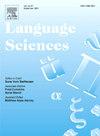A study of visual path expressions in Mandarin Chinese from the perspective of motion event typology
IF 1.1
2区 文学
Q2 EDUCATION & EDUCATIONAL RESEARCH
引用次数: 0
Abstract
Much attention has been paid to the typology of motion event expressions, and a recent focus is on whether the lexicalization pattern of motion event expressions is associated with other factors, such as event and construction types. This study made use of a Mandarin corpus to explore the extent to which the lexicalization pattern and associated linguistic features of motion event expressions transfer to one type of fictive motion event expressions, i.e., visual path expressions. Three types of visual path expressions were focused on, including the ones involving visual paths from the Experiencer to the Experienced entity with the person as the subject (Human-experiencer-subject visual paths), the ones of the same direction but with the eye-associated entity as the subject (Eye-experiencer-subject visual paths), and the ones from the Experienced entity to the Experiencer (Stimulus-subject visual paths). The results show that, in Mandarin, both Human-experiencer-subject and Stimulus-subject visual path expressions inherit the lexicalization pattern and associated linguistic features from motion event expressions, whereas Eye-experiencer-subject visual path expressions do not and they follow the pattern seen in a verb-framed language. Our results suggest that the lexicalization pattern of motion event expressions is associated with event and construction types.
从运动事件类型学的角度研究普通话中的视觉路径表达
运动事件表达式的类型学问题一直备受关注,最近的一个焦点是运动事件表达式的词汇化模式是否与其他因素(如事件和结构类型)相关。本研究利用普通话语料库,探讨了运动事件表达式的词化模式和相关语言特点在多大程度上可以迁移到一种虚构的运动事件表达式上,即视觉路径表达式。我们重点研究了三类视觉路径表达,包括以人为主体的从体验者到被体验者的视觉路径(人-体验者-主体视觉路径)、同方向但以眼睛相关实体为主体的视觉路径(眼睛-体验者-主体视觉路径)和从被体验者到体验者的视觉路径(刺激-主体视觉路径)。结果表明,在普通话中,"人-体验者-主体 "和 "刺激者-主体 "的视觉路径表达都继承了运动事件表达的词汇化模式和相关语言特点,而 "眼-体验者-主体 "的视觉路径表达则没有,它们遵循的是动词框架语言中的模式。我们的研究结果表明,运动事件表达式的词汇化模式与事件和结构类型有关。
本文章由计算机程序翻译,如有差异,请以英文原文为准。
求助全文
约1分钟内获得全文
求助全文
来源期刊

Language Sciences
Multiple-
CiteScore
2.90
自引率
0.00%
发文量
38
期刊介绍:
Language Sciences is a forum for debate, conducted so as to be of interest to the widest possible audience, on conceptual and theoretical issues in the various branches of general linguistics. The journal is also concerned with bringing to linguists attention current thinking about language within disciplines other than linguistics itself; relevant contributions from anthropologists, philosophers, psychologists and sociologists, among others, will be warmly received. In addition, the Editor is particularly keen to encourage the submission of essays on topics in the history and philosophy of language studies, and review articles discussing the import of significant recent works on language and linguistics.
 求助内容:
求助内容: 应助结果提醒方式:
应助结果提醒方式:


